Financial Analysis Report: Adidas and Puma Performance
VerifiedAdded on 2022/12/29
|24
|4901
|38
Report
AI Summary
This report presents a comprehensive financial analysis of Adidas and Puma, two prominent companies in the footwear and accessories industry. Utilizing the CORE approach, the analysis examines the external and internal environments of both companies, alongside their financial positions, including revenue, assets, liabilities, and equity. The report includes a detailed ratio analysis to evaluate the efficiency and performance of both companies. The study compares revenue trends, employee numbers, and key financial metrics from 2014 to 2018. The findings suggest that Adidas demonstrates a more appreciable financial performance compared to Puma, which leads to the recommendation of including Adidas in an investment portfolio. The report also considers industry-specific factors such as consumer behavior, market trends, and macroeconomic indicators, providing a holistic view of the companies' financial health and future prospects.
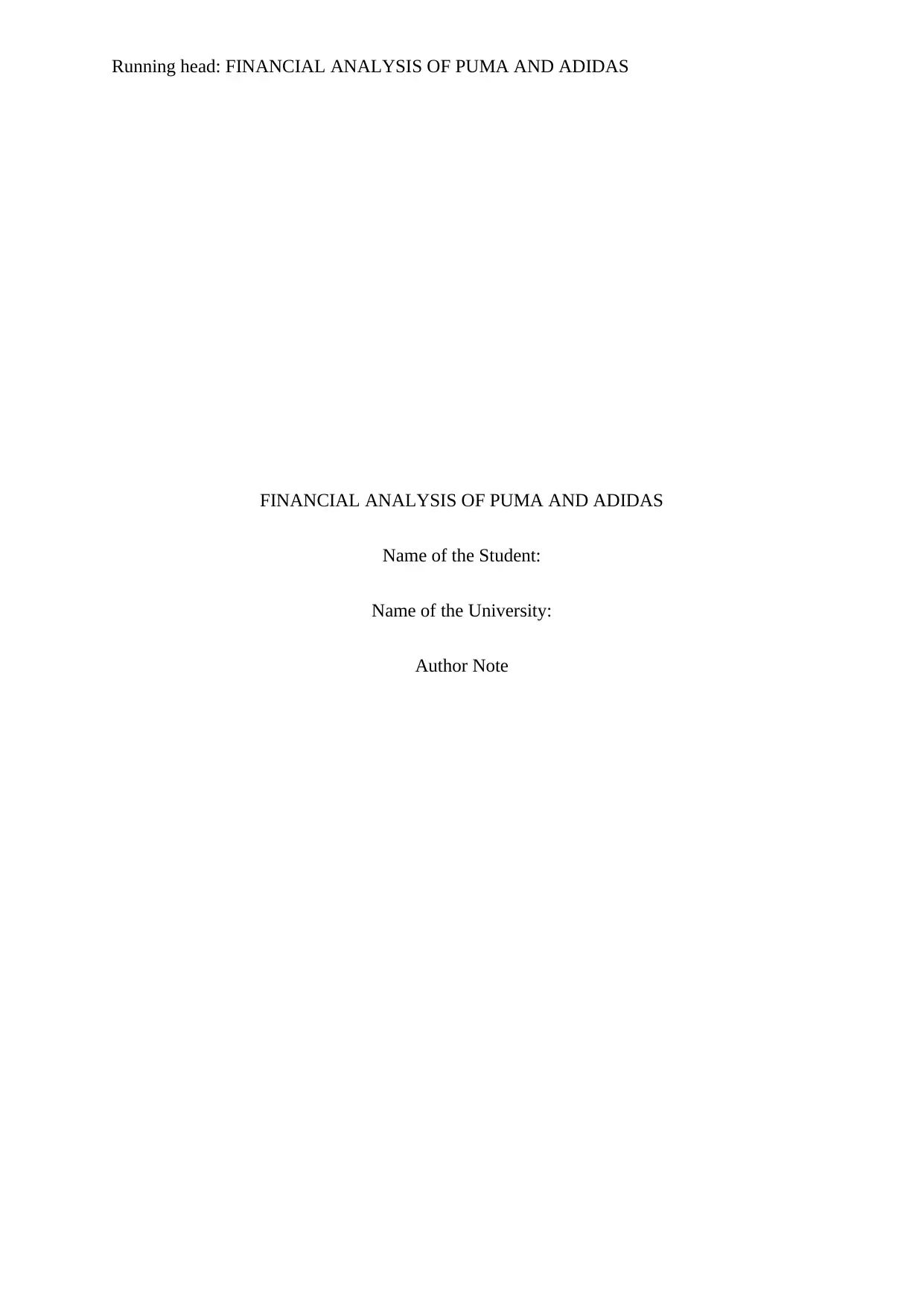
Running head: FINANCIAL ANALYSIS OF PUMA AND ADIDAS
FINANCIAL ANALYSIS OF PUMA AND ADIDAS
Name of the Student:
Name of the University:
Author Note
FINANCIAL ANALYSIS OF PUMA AND ADIDAS
Name of the Student:
Name of the University:
Author Note
Paraphrase This Document
Need a fresh take? Get an instant paraphrase of this document with our AI Paraphraser
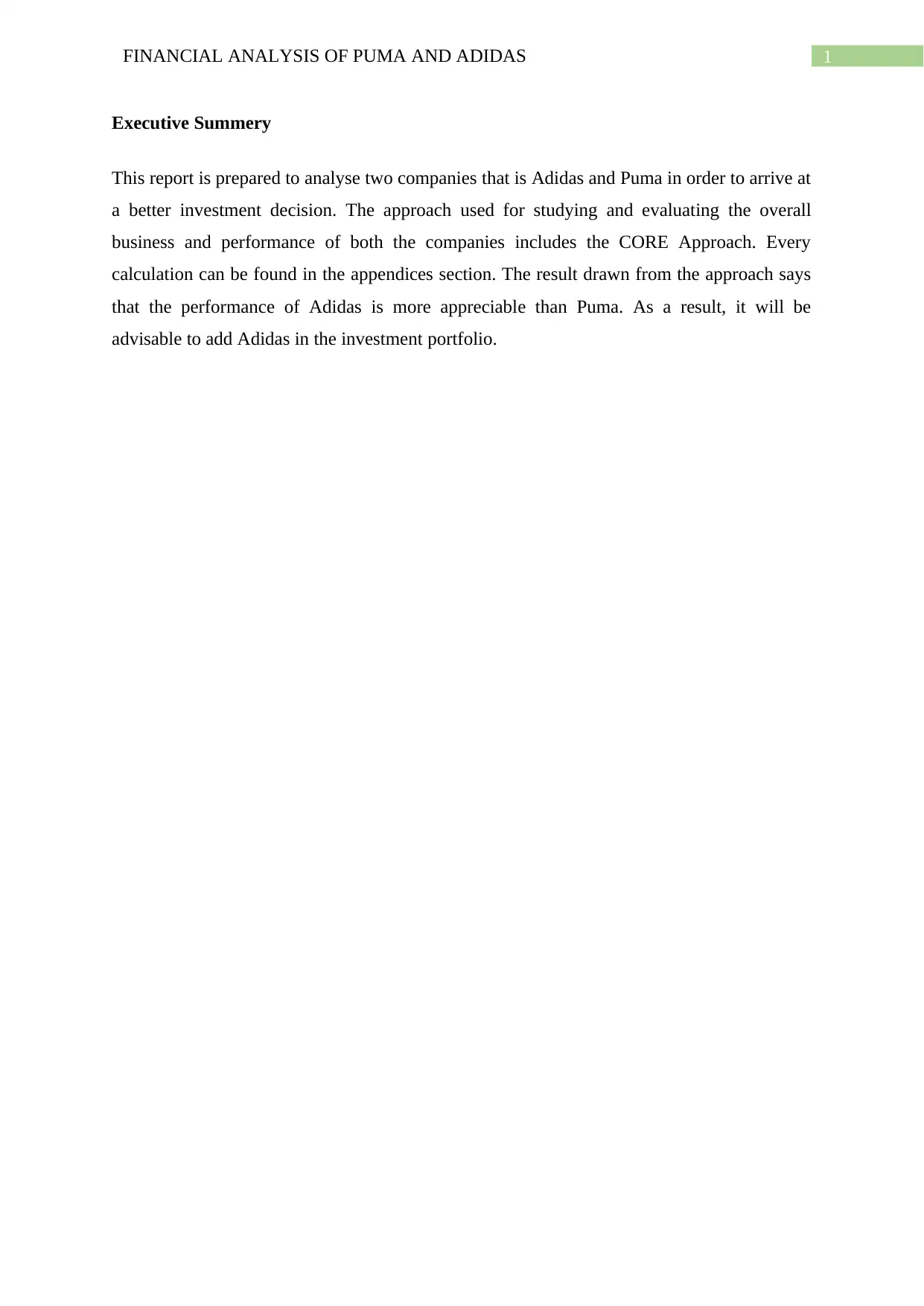
1FINANCIAL ANALYSIS OF PUMA AND ADIDAS
Executive Summery
This report is prepared to analyse two companies that is Adidas and Puma in order to arrive at
a better investment decision. The approach used for studying and evaluating the overall
business and performance of both the companies includes the CORE Approach. Every
calculation can be found in the appendices section. The result drawn from the approach says
that the performance of Adidas is more appreciable than Puma. As a result, it will be
advisable to add Adidas in the investment portfolio.
Executive Summery
This report is prepared to analyse two companies that is Adidas and Puma in order to arrive at
a better investment decision. The approach used for studying and evaluating the overall
business and performance of both the companies includes the CORE Approach. Every
calculation can be found in the appendices section. The result drawn from the approach says
that the performance of Adidas is more appreciable than Puma. As a result, it will be
advisable to add Adidas in the investment portfolio.
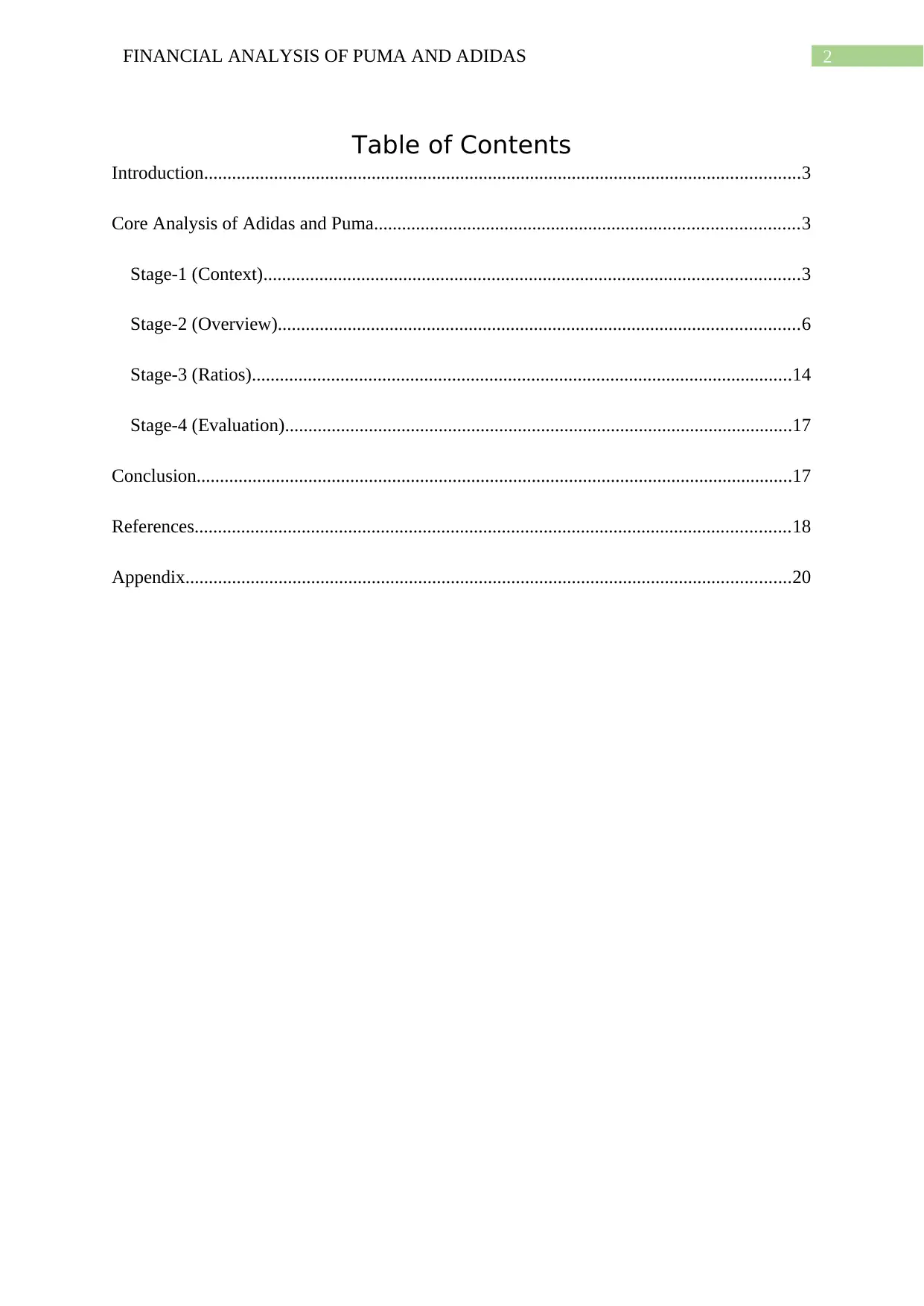
2FINANCIAL ANALYSIS OF PUMA AND ADIDAS
Table of Contents
Introduction................................................................................................................................3
Core Analysis of Adidas and Puma...........................................................................................3
Stage-1 (Context)...................................................................................................................3
Stage-2 (Overview)................................................................................................................6
Stage-3 (Ratios)....................................................................................................................14
Stage-4 (Evaluation).............................................................................................................17
Conclusion................................................................................................................................17
References................................................................................................................................18
Appendix..................................................................................................................................20
Table of Contents
Introduction................................................................................................................................3
Core Analysis of Adidas and Puma...........................................................................................3
Stage-1 (Context)...................................................................................................................3
Stage-2 (Overview)................................................................................................................6
Stage-3 (Ratios)....................................................................................................................14
Stage-4 (Evaluation).............................................................................................................17
Conclusion................................................................................................................................17
References................................................................................................................................18
Appendix..................................................................................................................................20
⊘ This is a preview!⊘
Do you want full access?
Subscribe today to unlock all pages.

Trusted by 1+ million students worldwide
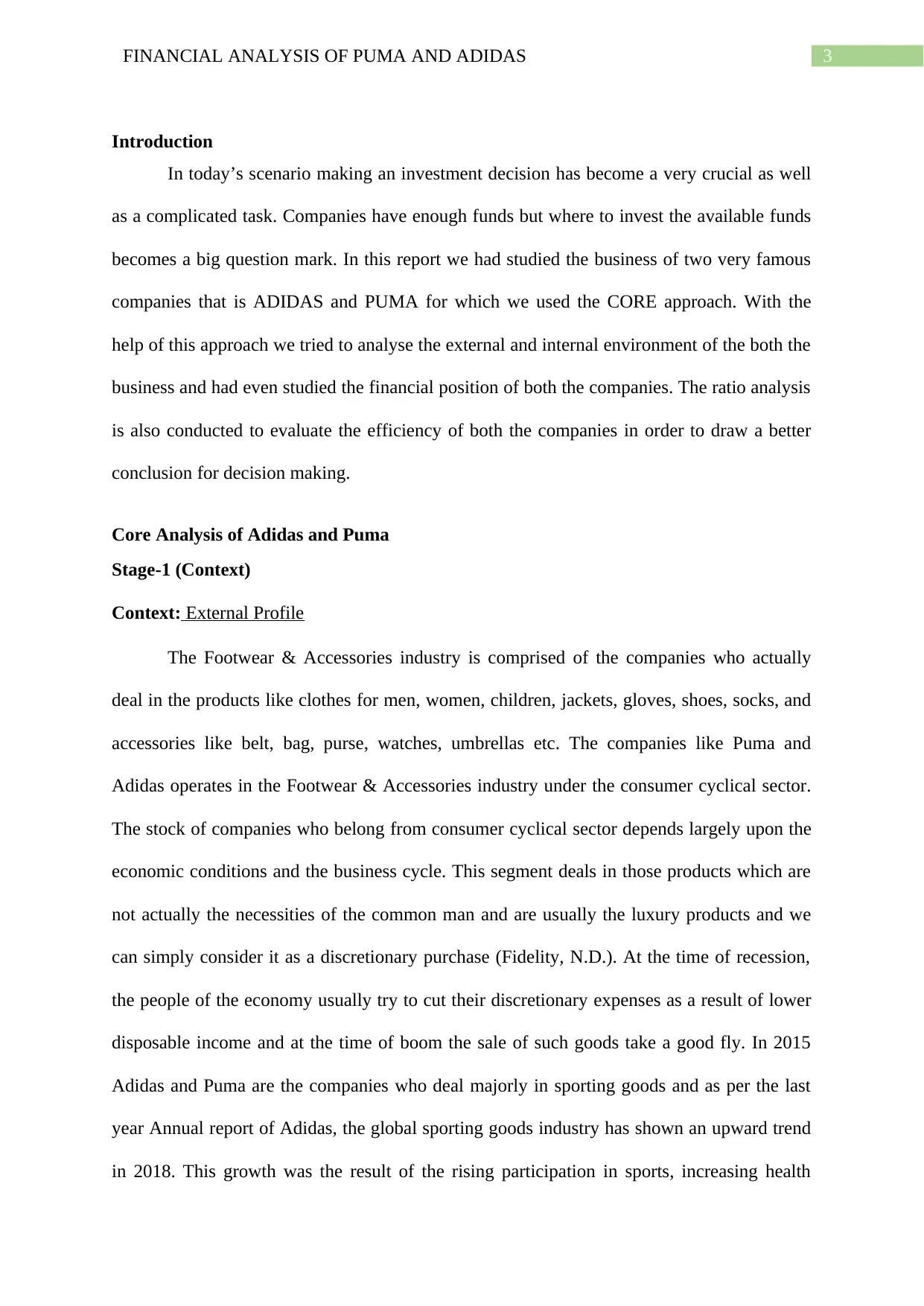
3FINANCIAL ANALYSIS OF PUMA AND ADIDAS
Introduction
In today’s scenario making an investment decision has become a very crucial as well
as a complicated task. Companies have enough funds but where to invest the available funds
becomes a big question mark. In this report we had studied the business of two very famous
companies that is ADIDAS and PUMA for which we used the CORE approach. With the
help of this approach we tried to analyse the external and internal environment of the both the
business and had even studied the financial position of both the companies. The ratio analysis
is also conducted to evaluate the efficiency of both the companies in order to draw a better
conclusion for decision making.
Core Analysis of Adidas and Puma
Stage-1 (Context)
Context: External Profile
The Footwear & Accessories industry is comprised of the companies who actually
deal in the products like clothes for men, women, children, jackets, gloves, shoes, socks, and
accessories like belt, bag, purse, watches, umbrellas etc. The companies like Puma and
Adidas operates in the Footwear & Accessories industry under the consumer cyclical sector.
The stock of companies who belong from consumer cyclical sector depends largely upon the
economic conditions and the business cycle. This segment deals in those products which are
not actually the necessities of the common man and are usually the luxury products and we
can simply consider it as a discretionary purchase (Fidelity, N.D.). At the time of recession,
the people of the economy usually try to cut their discretionary expenses as a result of lower
disposable income and at the time of boom the sale of such goods take a good fly. In 2015
Adidas and Puma are the companies who deal majorly in sporting goods and as per the last
year Annual report of Adidas, the global sporting goods industry has shown an upward trend
in 2018. This growth was the result of the rising participation in sports, increasing health
Introduction
In today’s scenario making an investment decision has become a very crucial as well
as a complicated task. Companies have enough funds but where to invest the available funds
becomes a big question mark. In this report we had studied the business of two very famous
companies that is ADIDAS and PUMA for which we used the CORE approach. With the
help of this approach we tried to analyse the external and internal environment of the both the
business and had even studied the financial position of both the companies. The ratio analysis
is also conducted to evaluate the efficiency of both the companies in order to draw a better
conclusion for decision making.
Core Analysis of Adidas and Puma
Stage-1 (Context)
Context: External Profile
The Footwear & Accessories industry is comprised of the companies who actually
deal in the products like clothes for men, women, children, jackets, gloves, shoes, socks, and
accessories like belt, bag, purse, watches, umbrellas etc. The companies like Puma and
Adidas operates in the Footwear & Accessories industry under the consumer cyclical sector.
The stock of companies who belong from consumer cyclical sector depends largely upon the
economic conditions and the business cycle. This segment deals in those products which are
not actually the necessities of the common man and are usually the luxury products and we
can simply consider it as a discretionary purchase (Fidelity, N.D.). At the time of recession,
the people of the economy usually try to cut their discretionary expenses as a result of lower
disposable income and at the time of boom the sale of such goods take a good fly. In 2015
Adidas and Puma are the companies who deal majorly in sporting goods and as per the last
year Annual report of Adidas, the global sporting goods industry has shown an upward trend
in 2018. This growth was the result of the rising participation in sports, increasing health
Paraphrase This Document
Need a fresh take? Get an instant paraphrase of this document with our AI Paraphraser
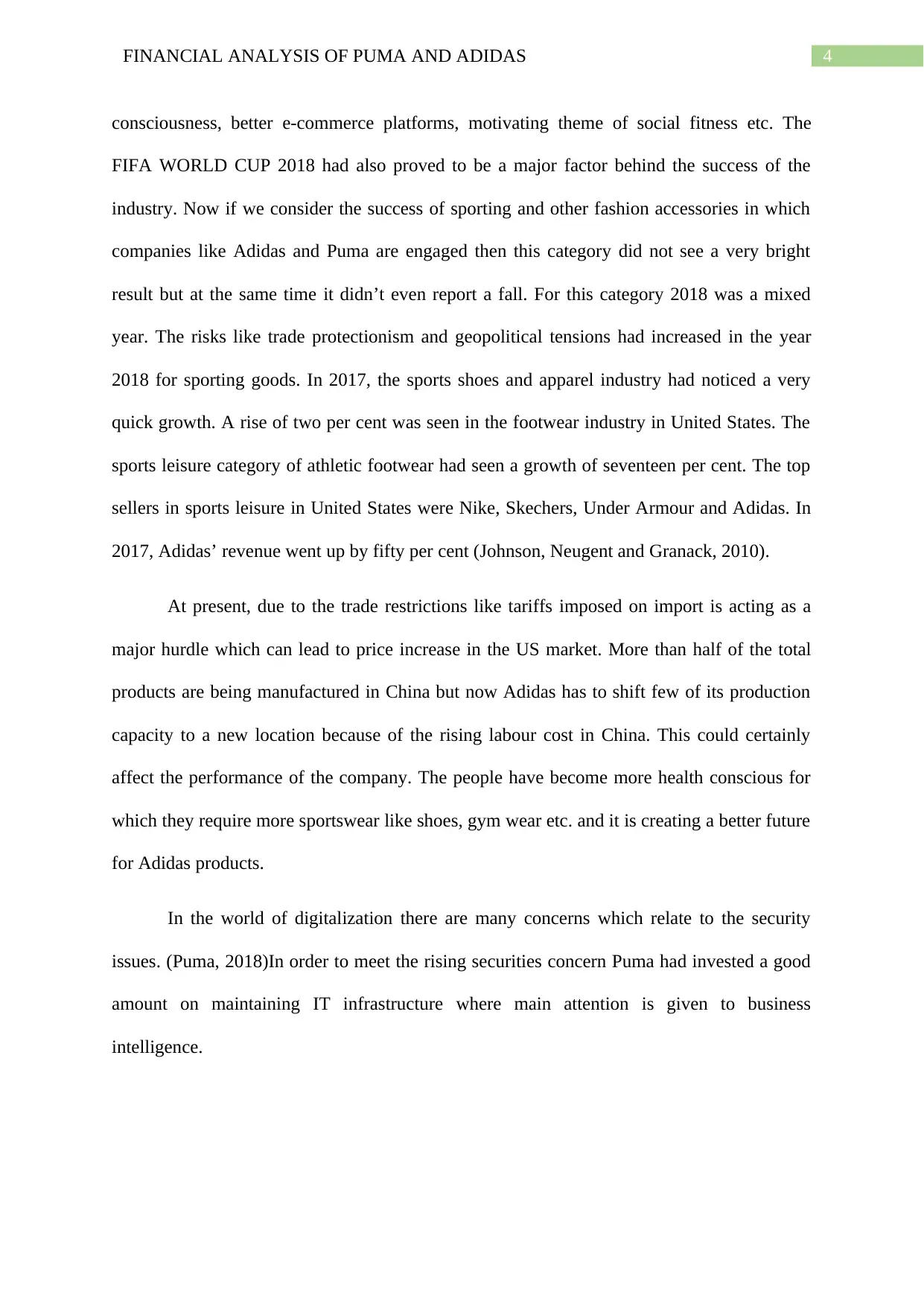
4FINANCIAL ANALYSIS OF PUMA AND ADIDAS
consciousness, better e-commerce platforms, motivating theme of social fitness etc. The
FIFA WORLD CUP 2018 had also proved to be a major factor behind the success of the
industry. Now if we consider the success of sporting and other fashion accessories in which
companies like Adidas and Puma are engaged then this category did not see a very bright
result but at the same time it didn’t even report a fall. For this category 2018 was a mixed
year. The risks like trade protectionism and geopolitical tensions had increased in the year
2018 for sporting goods. In 2017, the sports shoes and apparel industry had noticed a very
quick growth. A rise of two per cent was seen in the footwear industry in United States. The
sports leisure category of athletic footwear had seen a growth of seventeen per cent. The top
sellers in sports leisure in United States were Nike, Skechers, Under Armour and Adidas. In
2017, Adidas’ revenue went up by fifty per cent (Johnson, Neugent and Granack, 2010).
At present, due to the trade restrictions like tariffs imposed on import is acting as a
major hurdle which can lead to price increase in the US market. More than half of the total
products are being manufactured in China but now Adidas has to shift few of its production
capacity to a new location because of the rising labour cost in China. This could certainly
affect the performance of the company. The people have become more health conscious for
which they require more sportswear like shoes, gym wear etc. and it is creating a better future
for Adidas products.
In the world of digitalization there are many concerns which relate to the security
issues. (Puma, 2018)In order to meet the rising securities concern Puma had invested a good
amount on maintaining IT infrastructure where main attention is given to business
intelligence.
consciousness, better e-commerce platforms, motivating theme of social fitness etc. The
FIFA WORLD CUP 2018 had also proved to be a major factor behind the success of the
industry. Now if we consider the success of sporting and other fashion accessories in which
companies like Adidas and Puma are engaged then this category did not see a very bright
result but at the same time it didn’t even report a fall. For this category 2018 was a mixed
year. The risks like trade protectionism and geopolitical tensions had increased in the year
2018 for sporting goods. In 2017, the sports shoes and apparel industry had noticed a very
quick growth. A rise of two per cent was seen in the footwear industry in United States. The
sports leisure category of athletic footwear had seen a growth of seventeen per cent. The top
sellers in sports leisure in United States were Nike, Skechers, Under Armour and Adidas. In
2017, Adidas’ revenue went up by fifty per cent (Johnson, Neugent and Granack, 2010).
At present, due to the trade restrictions like tariffs imposed on import is acting as a
major hurdle which can lead to price increase in the US market. More than half of the total
products are being manufactured in China but now Adidas has to shift few of its production
capacity to a new location because of the rising labour cost in China. This could certainly
affect the performance of the company. The people have become more health conscious for
which they require more sportswear like shoes, gym wear etc. and it is creating a better future
for Adidas products.
In the world of digitalization there are many concerns which relate to the security
issues. (Puma, 2018)In order to meet the rising securities concern Puma had invested a good
amount on maintaining IT infrastructure where main attention is given to business
intelligence.
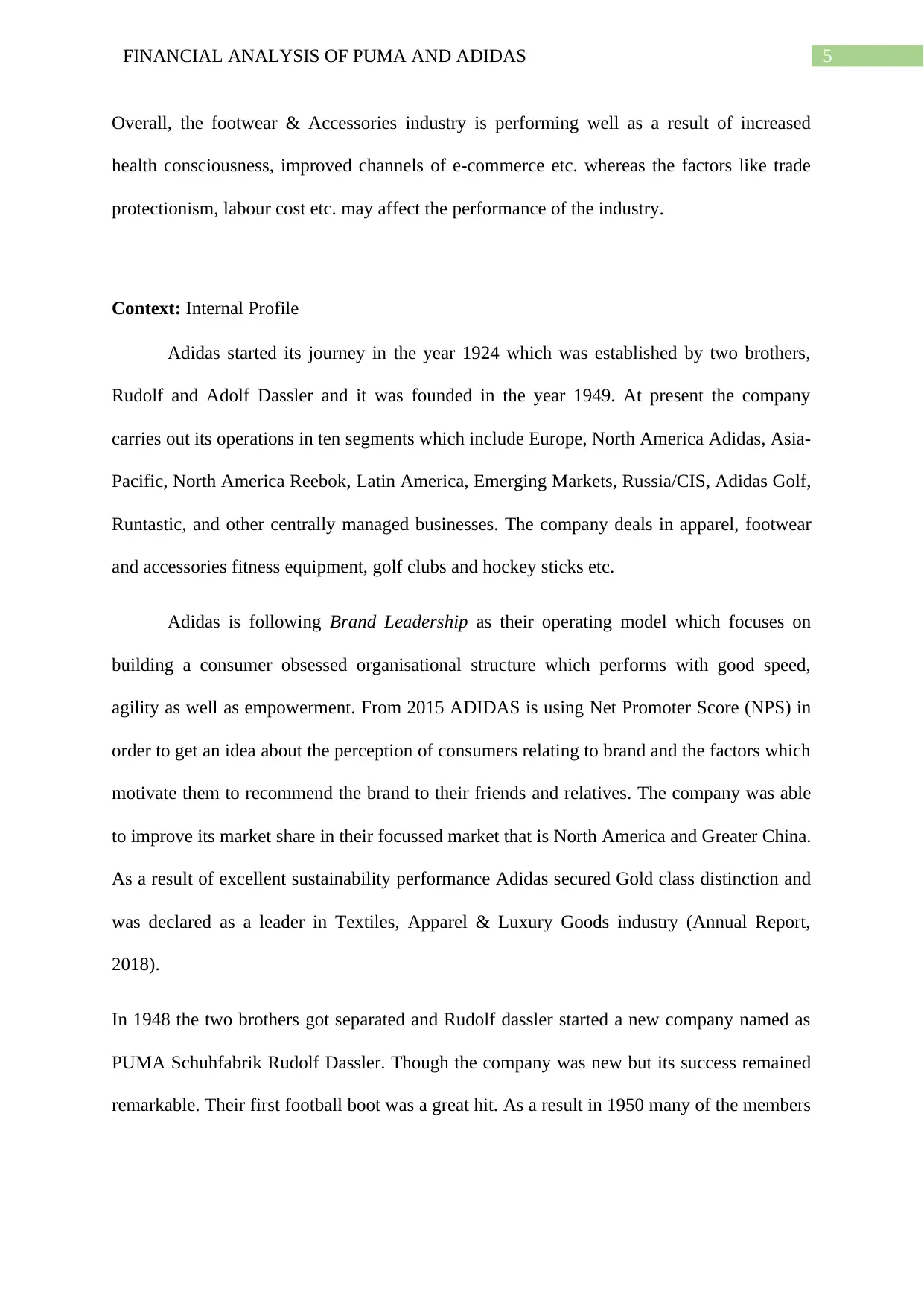
5FINANCIAL ANALYSIS OF PUMA AND ADIDAS
Overall, the footwear & Accessories industry is performing well as a result of increased
health consciousness, improved channels of e-commerce etc. whereas the factors like trade
protectionism, labour cost etc. may affect the performance of the industry.
Context: Internal Profile
Adidas started its journey in the year 1924 which was established by two brothers,
Rudolf and Adolf Dassler and it was founded in the year 1949. At present the company
carries out its operations in ten segments which include Europe, North America Adidas, Asia-
Pacific, North America Reebok, Latin America, Emerging Markets, Russia/CIS, Adidas Golf,
Runtastic, and other centrally managed businesses. The company deals in apparel, footwear
and accessories fitness equipment, golf clubs and hockey sticks etc.
Adidas is following Brand Leadership as their operating model which focuses on
building a consumer obsessed organisational structure which performs with good speed,
agility as well as empowerment. From 2015 ADIDAS is using Net Promoter Score (NPS) in
order to get an idea about the perception of consumers relating to brand and the factors which
motivate them to recommend the brand to their friends and relatives. The company was able
to improve its market share in their focussed market that is North America and Greater China.
As a result of excellent sustainability performance Adidas secured Gold class distinction and
was declared as a leader in Textiles, Apparel & Luxury Goods industry (Annual Report,
2018).
In 1948 the two brothers got separated and Rudolf dassler started a new company named as
PUMA Schuhfabrik Rudolf Dassler. Though the company was new but its success remained
remarkable. Their first football boot was a great hit. As a result in 1950 many of the members
Overall, the footwear & Accessories industry is performing well as a result of increased
health consciousness, improved channels of e-commerce etc. whereas the factors like trade
protectionism, labour cost etc. may affect the performance of the industry.
Context: Internal Profile
Adidas started its journey in the year 1924 which was established by two brothers,
Rudolf and Adolf Dassler and it was founded in the year 1949. At present the company
carries out its operations in ten segments which include Europe, North America Adidas, Asia-
Pacific, North America Reebok, Latin America, Emerging Markets, Russia/CIS, Adidas Golf,
Runtastic, and other centrally managed businesses. The company deals in apparel, footwear
and accessories fitness equipment, golf clubs and hockey sticks etc.
Adidas is following Brand Leadership as their operating model which focuses on
building a consumer obsessed organisational structure which performs with good speed,
agility as well as empowerment. From 2015 ADIDAS is using Net Promoter Score (NPS) in
order to get an idea about the perception of consumers relating to brand and the factors which
motivate them to recommend the brand to their friends and relatives. The company was able
to improve its market share in their focussed market that is North America and Greater China.
As a result of excellent sustainability performance Adidas secured Gold class distinction and
was declared as a leader in Textiles, Apparel & Luxury Goods industry (Annual Report,
2018).
In 1948 the two brothers got separated and Rudolf dassler started a new company named as
PUMA Schuhfabrik Rudolf Dassler. Though the company was new but its success remained
remarkable. Their first football boot was a great hit. As a result in 1950 many of the members
⊘ This is a preview!⊘
Do you want full access?
Subscribe today to unlock all pages.

Trusted by 1+ million students worldwide
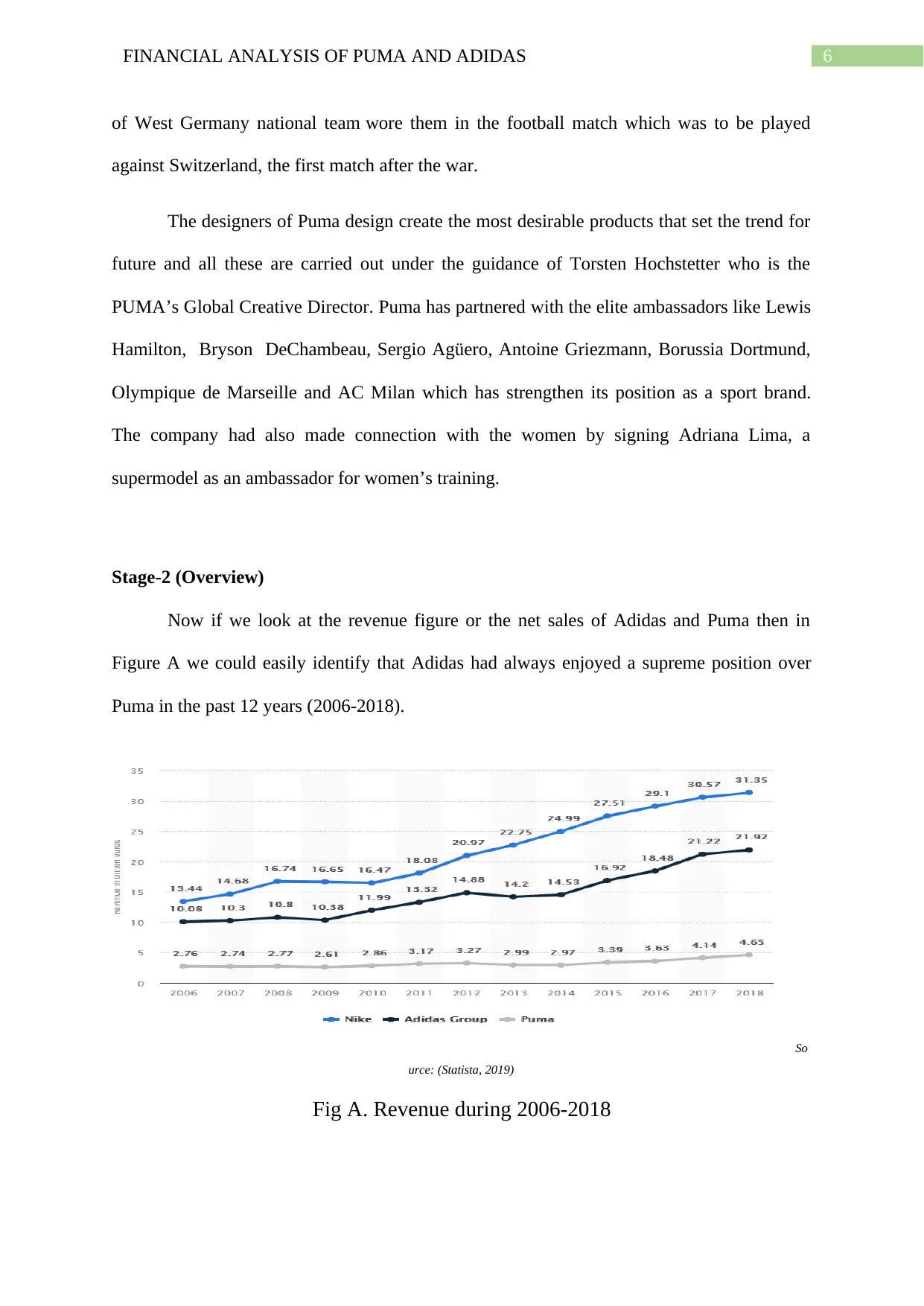
6FINANCIAL ANALYSIS OF PUMA AND ADIDAS
of West Germany national team wore them in the football match which was to be played
against Switzerland, the first match after the war.
The designers of Puma design create the most desirable products that set the trend for
future and all these are carried out under the guidance of Torsten Hochstetter who is the
PUMA’s Global Creative Director. Puma has partnered with the elite ambassadors like Lewis
Hamilton, Bryson DeChambeau, Sergio Agüero, Antoine Griezmann, Borussia Dortmund,
Olympique de Marseille and AC Milan which has strengthen its position as a sport brand.
The company had also made connection with the women by signing Adriana Lima, a
supermodel as an ambassador for women’s training.
Stage-2 (Overview)
Now if we look at the revenue figure or the net sales of Adidas and Puma then in
Figure A we could easily identify that Adidas had always enjoyed a supreme position over
Puma in the past 12 years (2006-2018).
So
urce: (Statista, 2019)
Fig A. Revenue during 2006-2018
of West Germany national team wore them in the football match which was to be played
against Switzerland, the first match after the war.
The designers of Puma design create the most desirable products that set the trend for
future and all these are carried out under the guidance of Torsten Hochstetter who is the
PUMA’s Global Creative Director. Puma has partnered with the elite ambassadors like Lewis
Hamilton, Bryson DeChambeau, Sergio Agüero, Antoine Griezmann, Borussia Dortmund,
Olympique de Marseille and AC Milan which has strengthen its position as a sport brand.
The company had also made connection with the women by signing Adriana Lima, a
supermodel as an ambassador for women’s training.
Stage-2 (Overview)
Now if we look at the revenue figure or the net sales of Adidas and Puma then in
Figure A we could easily identify that Adidas had always enjoyed a supreme position over
Puma in the past 12 years (2006-2018).
So
urce: (Statista, 2019)
Fig A. Revenue during 2006-2018
Paraphrase This Document
Need a fresh take? Get an instant paraphrase of this document with our AI Paraphraser
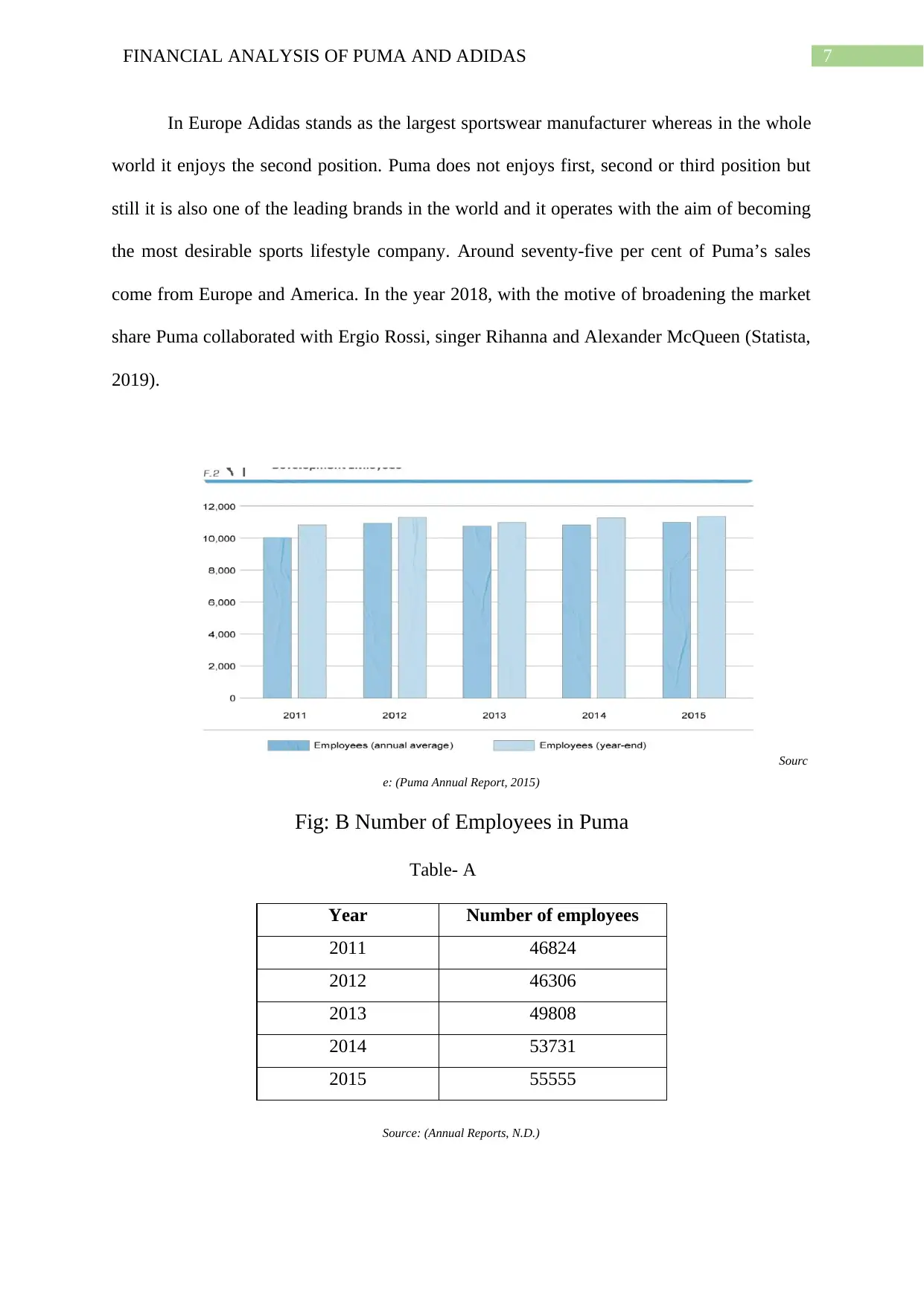
7FINANCIAL ANALYSIS OF PUMA AND ADIDAS
In Europe Adidas stands as the largest sportswear manufacturer whereas in the whole
world it enjoys the second position. Puma does not enjoys first, second or third position but
still it is also one of the leading brands in the world and it operates with the aim of becoming
the most desirable sports lifestyle company. Around seventy-five per cent of Puma’s sales
come from Europe and America. In the year 2018, with the motive of broadening the market
share Puma collaborated with Ergio Rossi, singer Rihanna and Alexander McQueen (Statista,
2019).
Sourc
e: (Puma Annual Report, 2015)
Fig: B Number of Employees in Puma
Table- A
Source: (Annual Reports, N.D.)
Year Number of employees
2011 46824
2012 46306
2013 49808
2014 53731
2015 55555
In Europe Adidas stands as the largest sportswear manufacturer whereas in the whole
world it enjoys the second position. Puma does not enjoys first, second or third position but
still it is also one of the leading brands in the world and it operates with the aim of becoming
the most desirable sports lifestyle company. Around seventy-five per cent of Puma’s sales
come from Europe and America. In the year 2018, with the motive of broadening the market
share Puma collaborated with Ergio Rossi, singer Rihanna and Alexander McQueen (Statista,
2019).
Sourc
e: (Puma Annual Report, 2015)
Fig: B Number of Employees in Puma
Table- A
Source: (Annual Reports, N.D.)
Year Number of employees
2011 46824
2012 46306
2013 49808
2014 53731
2015 55555
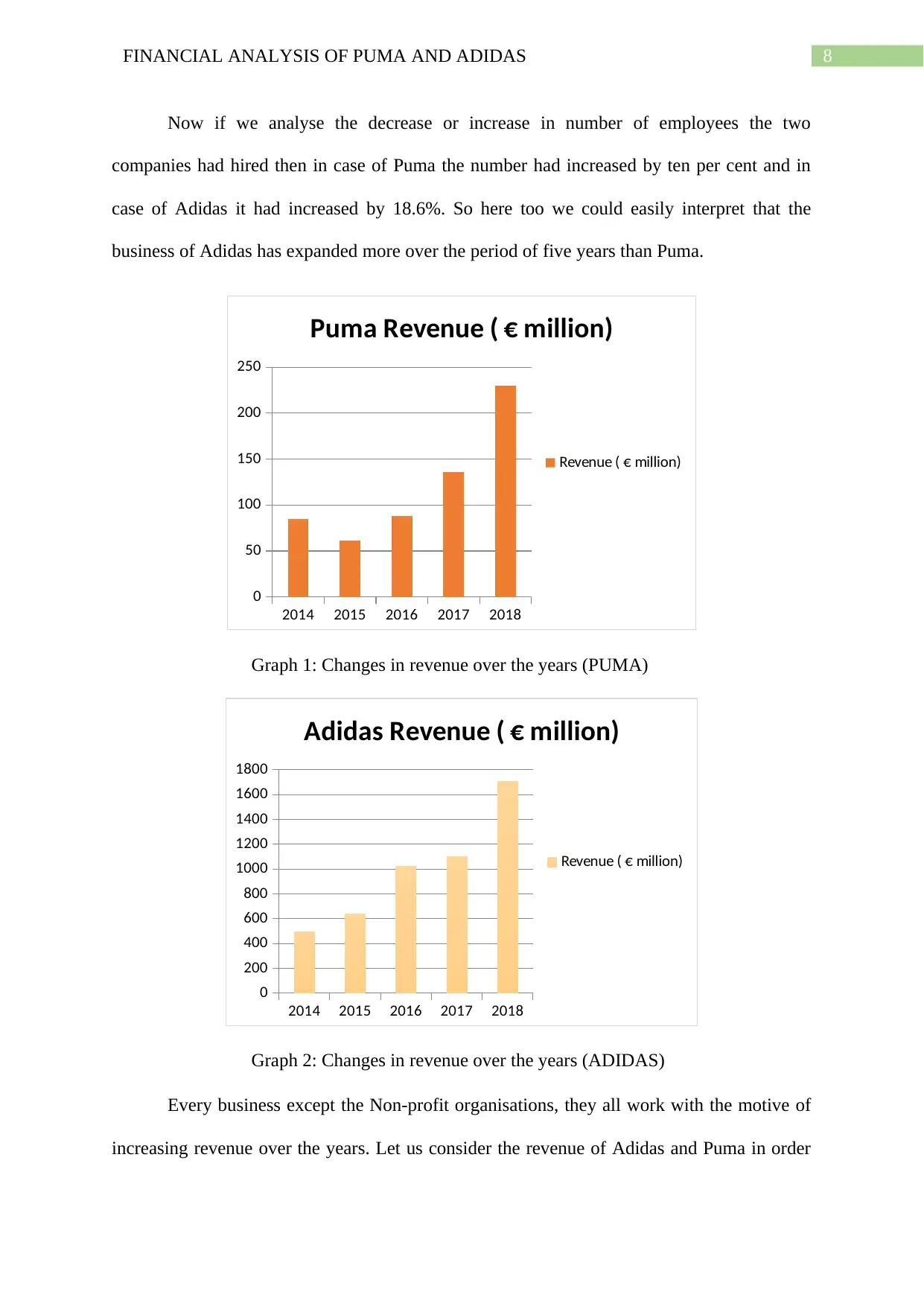
8FINANCIAL ANALYSIS OF PUMA AND ADIDAS
Now if we analyse the decrease or increase in number of employees the two
companies had hired then in case of Puma the number had increased by ten per cent and in
case of Adidas it had increased by 18.6%. So here too we could easily interpret that the
business of Adidas has expanded more over the period of five years than Puma.
2014 2015 2016 2017 2018
0
50
100
150
200
250
Puma Revenue ( € million)
Revenue ( € million)
Graph 1: Changes in revenue over the years (PUMA)
2014 2015 2016 2017 2018
0
200
400
600
800
1000
1200
1400
1600
1800
Adidas Revenue ( € million)
Revenue ( € million)
Graph 2: Changes in revenue over the years (ADIDAS)
Every business except the Non-profit organisations, they all work with the motive of
increasing revenue over the years. Let us consider the revenue of Adidas and Puma in order
Now if we analyse the decrease or increase in number of employees the two
companies had hired then in case of Puma the number had increased by ten per cent and in
case of Adidas it had increased by 18.6%. So here too we could easily interpret that the
business of Adidas has expanded more over the period of five years than Puma.
2014 2015 2016 2017 2018
0
50
100
150
200
250
Puma Revenue ( € million)
Revenue ( € million)
Graph 1: Changes in revenue over the years (PUMA)
2014 2015 2016 2017 2018
0
200
400
600
800
1000
1200
1400
1600
1800
Adidas Revenue ( € million)
Revenue ( € million)
Graph 2: Changes in revenue over the years (ADIDAS)
Every business except the Non-profit organisations, they all work with the motive of
increasing revenue over the years. Let us consider the revenue of Adidas and Puma in order
⊘ This is a preview!⊘
Do you want full access?
Subscribe today to unlock all pages.

Trusted by 1+ million students worldwide
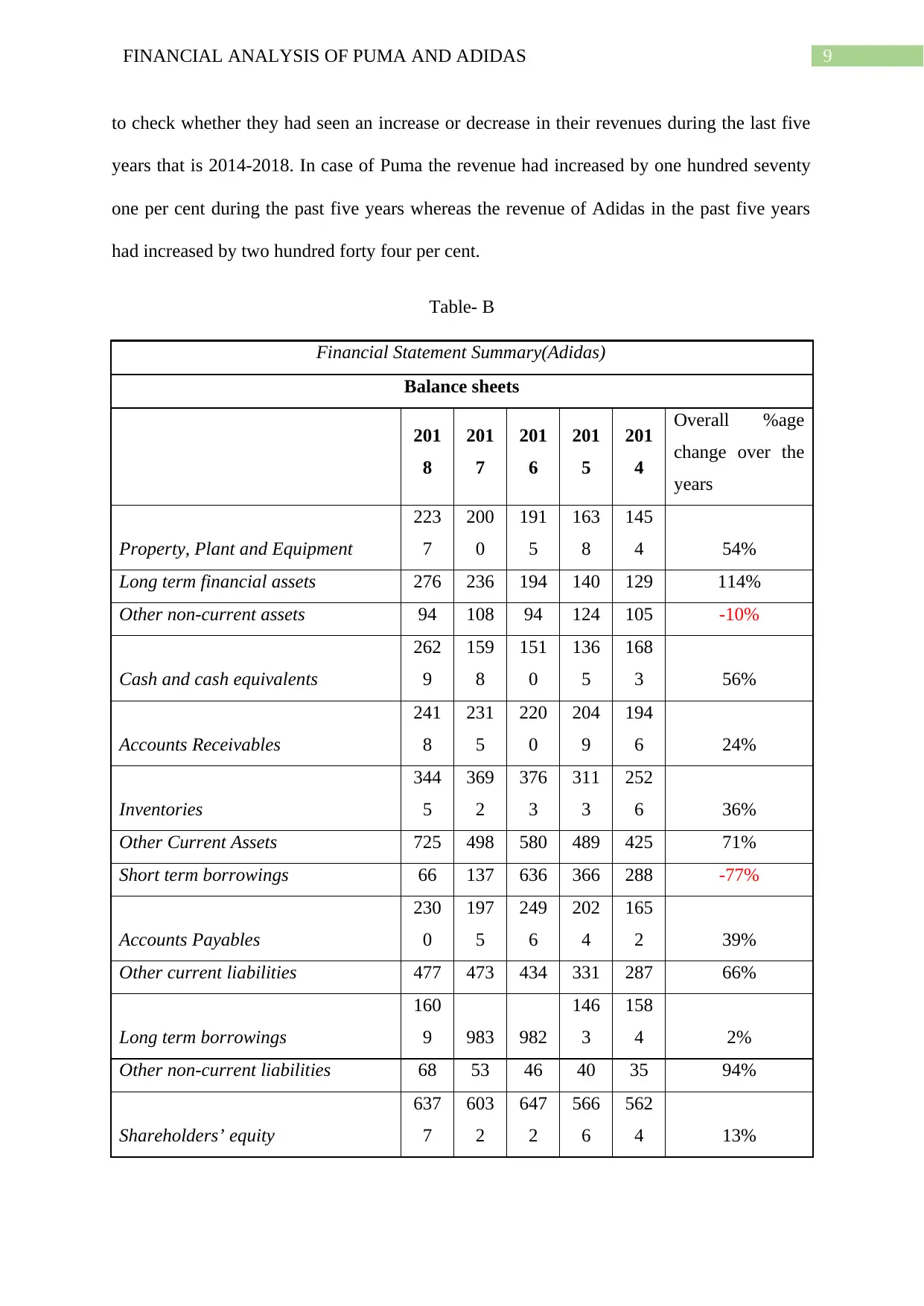
9FINANCIAL ANALYSIS OF PUMA AND ADIDAS
to check whether they had seen an increase or decrease in their revenues during the last five
years that is 2014-2018. In case of Puma the revenue had increased by one hundred seventy
one per cent during the past five years whereas the revenue of Adidas in the past five years
had increased by two hundred forty four per cent.
Table- B
Financial Statement Summary(Adidas)
Balance sheets
201
8
201
7
201
6
201
5
201
4
Overall %age
change over the
years
Property, Plant and Equipment
223
7
200
0
191
5
163
8
145
4 54%
Long term financial assets 276 236 194 140 129 114%
Other non-current assets 94 108 94 124 105 -10%
Cash and cash equivalents
262
9
159
8
151
0
136
5
168
3 56%
Accounts Receivables
241
8
231
5
220
0
204
9
194
6 24%
Inventories
344
5
369
2
376
3
311
3
252
6 36%
Other Current Assets 725 498 580 489 425 71%
Short term borrowings 66 137 636 366 288 -77%
Accounts Payables
230
0
197
5
249
6
202
4
165
2 39%
Other current liabilities 477 473 434 331 287 66%
Long term borrowings
160
9 983 982
146
3
158
4 2%
Other non-current liabilities 68 53 46 40 35 94%
Shareholders’ equity
637
7
603
2
647
2
566
6
562
4 13%
to check whether they had seen an increase or decrease in their revenues during the last five
years that is 2014-2018. In case of Puma the revenue had increased by one hundred seventy
one per cent during the past five years whereas the revenue of Adidas in the past five years
had increased by two hundred forty four per cent.
Table- B
Financial Statement Summary(Adidas)
Balance sheets
201
8
201
7
201
6
201
5
201
4
Overall %age
change over the
years
Property, Plant and Equipment
223
7
200
0
191
5
163
8
145
4 54%
Long term financial assets 276 236 194 140 129 114%
Other non-current assets 94 108 94 124 105 -10%
Cash and cash equivalents
262
9
159
8
151
0
136
5
168
3 56%
Accounts Receivables
241
8
231
5
220
0
204
9
194
6 24%
Inventories
344
5
369
2
376
3
311
3
252
6 36%
Other Current Assets 725 498 580 489 425 71%
Short term borrowings 66 137 636 366 288 -77%
Accounts Payables
230
0
197
5
249
6
202
4
165
2 39%
Other current liabilities 477 473 434 331 287 66%
Long term borrowings
160
9 983 982
146
3
158
4 2%
Other non-current liabilities 68 53 46 40 35 94%
Shareholders’ equity
637
7
603
2
647
2
566
6
562
4 13%
Paraphrase This Document
Need a fresh take? Get an instant paraphrase of this document with our AI Paraphraser
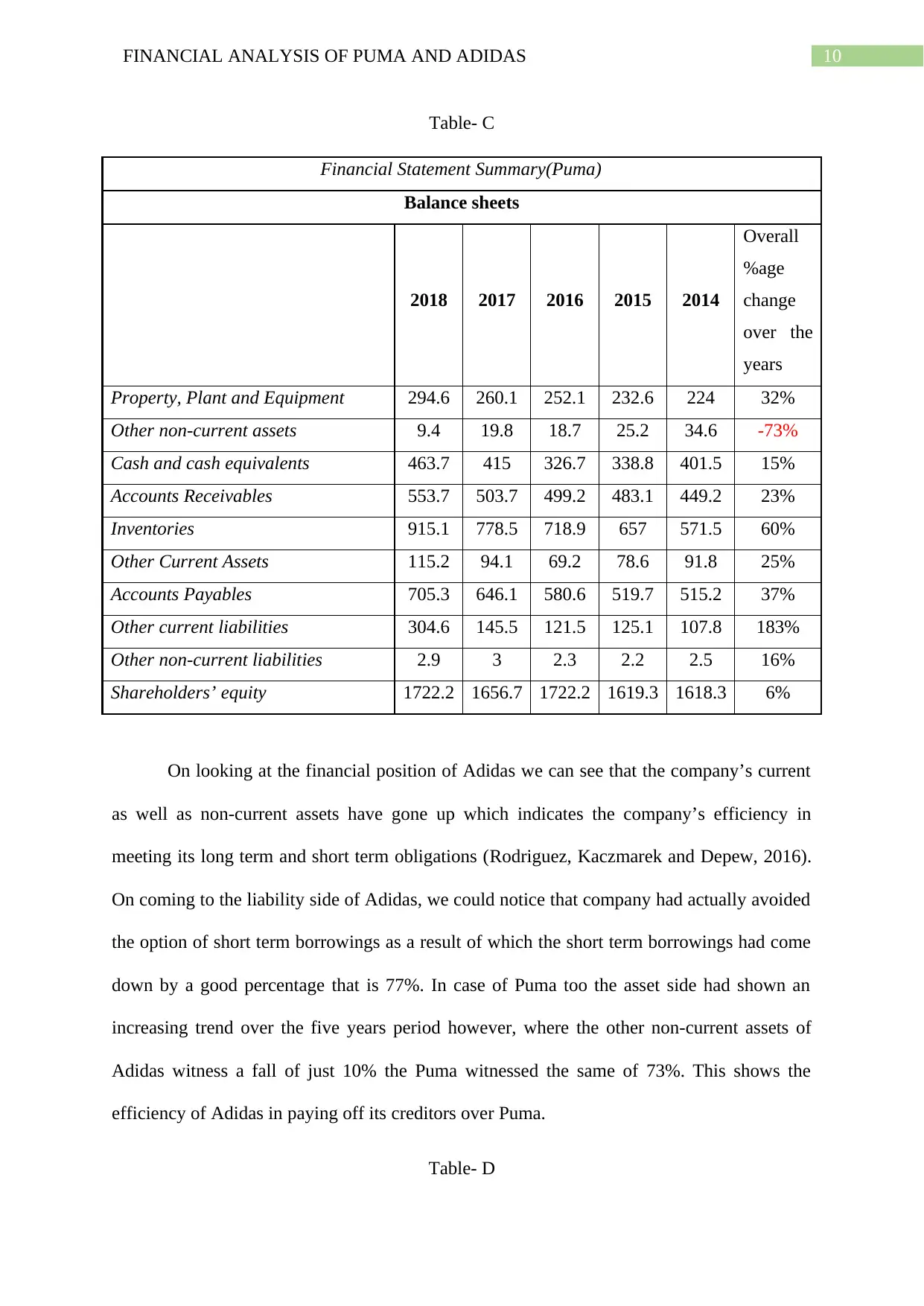
10FINANCIAL ANALYSIS OF PUMA AND ADIDAS
Table- C
Financial Statement Summary(Puma)
Balance sheets
2018 2017 2016 2015 2014
Overall
%age
change
over the
years
Property, Plant and Equipment 294.6 260.1 252.1 232.6 224 32%
Other non-current assets 9.4 19.8 18.7 25.2 34.6 -73%
Cash and cash equivalents 463.7 415 326.7 338.8 401.5 15%
Accounts Receivables 553.7 503.7 499.2 483.1 449.2 23%
Inventories 915.1 778.5 718.9 657 571.5 60%
Other Current Assets 115.2 94.1 69.2 78.6 91.8 25%
Accounts Payables 705.3 646.1 580.6 519.7 515.2 37%
Other current liabilities 304.6 145.5 121.5 125.1 107.8 183%
Other non-current liabilities 2.9 3 2.3 2.2 2.5 16%
Shareholders’ equity 1722.2 1656.7 1722.2 1619.3 1618.3 6%
On looking at the financial position of Adidas we can see that the company’s current
as well as non-current assets have gone up which indicates the company’s efficiency in
meeting its long term and short term obligations (Rodriguez, Kaczmarek and Depew, 2016).
On coming to the liability side of Adidas, we could notice that company had actually avoided
the option of short term borrowings as a result of which the short term borrowings had come
down by a good percentage that is 77%. In case of Puma too the asset side had shown an
increasing trend over the five years period however, where the other non-current assets of
Adidas witness a fall of just 10% the Puma witnessed the same of 73%. This shows the
efficiency of Adidas in paying off its creditors over Puma.
Table- D
Table- C
Financial Statement Summary(Puma)
Balance sheets
2018 2017 2016 2015 2014
Overall
%age
change
over the
years
Property, Plant and Equipment 294.6 260.1 252.1 232.6 224 32%
Other non-current assets 9.4 19.8 18.7 25.2 34.6 -73%
Cash and cash equivalents 463.7 415 326.7 338.8 401.5 15%
Accounts Receivables 553.7 503.7 499.2 483.1 449.2 23%
Inventories 915.1 778.5 718.9 657 571.5 60%
Other Current Assets 115.2 94.1 69.2 78.6 91.8 25%
Accounts Payables 705.3 646.1 580.6 519.7 515.2 37%
Other current liabilities 304.6 145.5 121.5 125.1 107.8 183%
Other non-current liabilities 2.9 3 2.3 2.2 2.5 16%
Shareholders’ equity 1722.2 1656.7 1722.2 1619.3 1618.3 6%
On looking at the financial position of Adidas we can see that the company’s current
as well as non-current assets have gone up which indicates the company’s efficiency in
meeting its long term and short term obligations (Rodriguez, Kaczmarek and Depew, 2016).
On coming to the liability side of Adidas, we could notice that company had actually avoided
the option of short term borrowings as a result of which the short term borrowings had come
down by a good percentage that is 77%. In case of Puma too the asset side had shown an
increasing trend over the five years period however, where the other non-current assets of
Adidas witness a fall of just 10% the Puma witnessed the same of 73%. This shows the
efficiency of Adidas in paying off its creditors over Puma.
Table- D
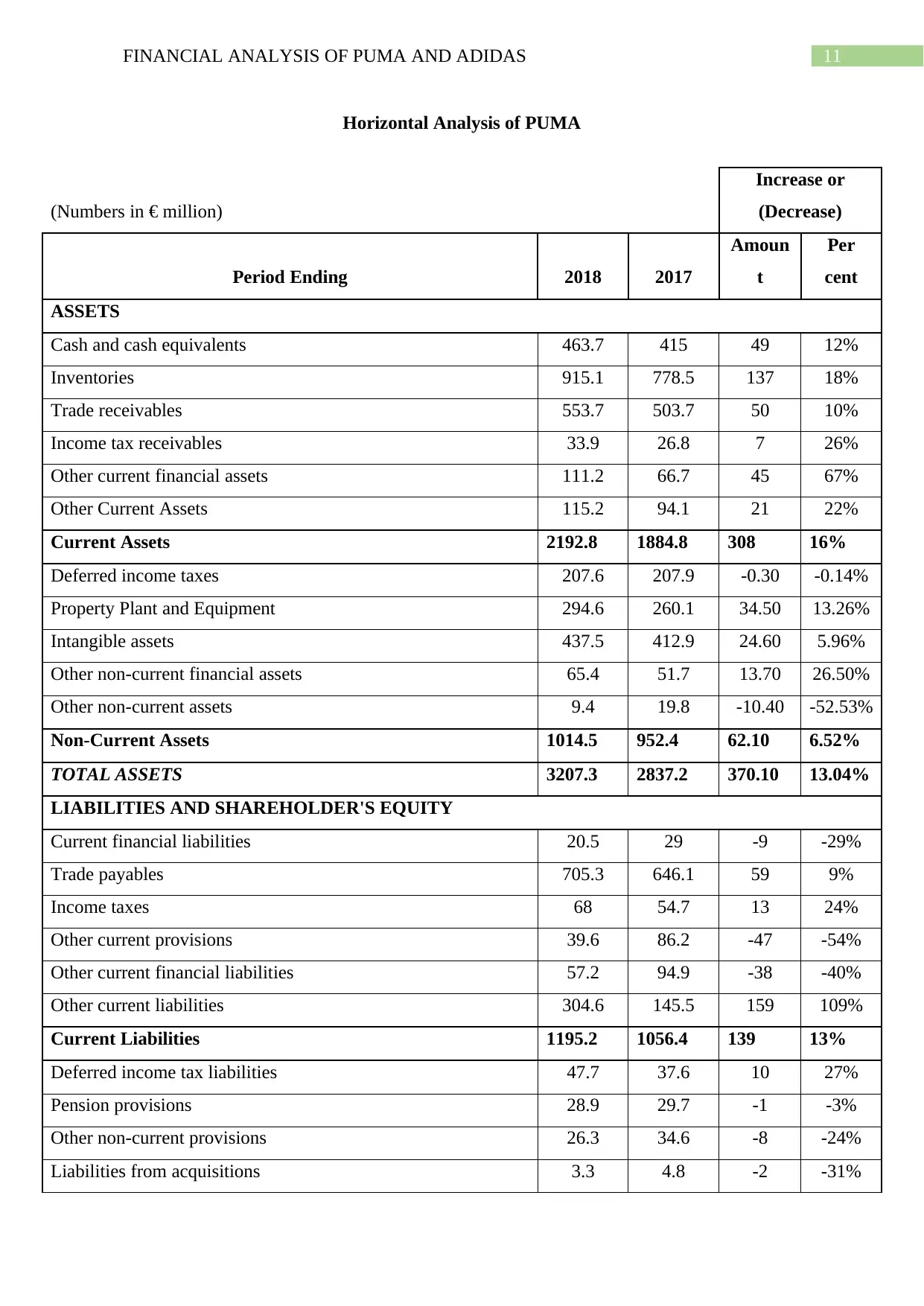
11FINANCIAL ANALYSIS OF PUMA AND ADIDAS
Horizontal Analysis of PUMA
(Numbers in € million)
Increase or
(Decrease)
Period Ending 2018 2017
Amoun
t
Per
cent
ASSETS
Cash and cash equivalents 463.7 415 49 12%
Inventories 915.1 778.5 137 18%
Trade receivables 553.7 503.7 50 10%
Income tax receivables 33.9 26.8 7 26%
Other current financial assets 111.2 66.7 45 67%
Other Current Assets 115.2 94.1 21 22%
Current Assets 2192.8 1884.8 308 16%
Deferred income taxes 207.6 207.9 -0.30 -0.14%
Property Plant and Equipment 294.6 260.1 34.50 13.26%
Intangible assets 437.5 412.9 24.60 5.96%
Other non-current financial assets 65.4 51.7 13.70 26.50%
Other non-current assets 9.4 19.8 -10.40 -52.53%
Non-Current Assets 1014.5 952.4 62.10 6.52%
TOTAL ASSETS 3207.3 2837.2 370.10 13.04%
LIABILITIES AND SHAREHOLDER'S EQUITY
Current financial liabilities 20.5 29 -9 -29%
Trade payables 705.3 646.1 59 9%
Income taxes 68 54.7 13 24%
Other current provisions 39.6 86.2 -47 -54%
Other current financial liabilities 57.2 94.9 -38 -40%
Other current liabilities 304.6 145.5 159 109%
Current Liabilities 1195.2 1056.4 139 13%
Deferred income tax liabilities 47.7 37.6 10 27%
Pension provisions 28.9 29.7 -1 -3%
Other non-current provisions 26.3 34.6 -8 -24%
Liabilities from acquisitions 3.3 4.8 -2 -31%
Horizontal Analysis of PUMA
(Numbers in € million)
Increase or
(Decrease)
Period Ending 2018 2017
Amoun
t
Per
cent
ASSETS
Cash and cash equivalents 463.7 415 49 12%
Inventories 915.1 778.5 137 18%
Trade receivables 553.7 503.7 50 10%
Income tax receivables 33.9 26.8 7 26%
Other current financial assets 111.2 66.7 45 67%
Other Current Assets 115.2 94.1 21 22%
Current Assets 2192.8 1884.8 308 16%
Deferred income taxes 207.6 207.9 -0.30 -0.14%
Property Plant and Equipment 294.6 260.1 34.50 13.26%
Intangible assets 437.5 412.9 24.60 5.96%
Other non-current financial assets 65.4 51.7 13.70 26.50%
Other non-current assets 9.4 19.8 -10.40 -52.53%
Non-Current Assets 1014.5 952.4 62.10 6.52%
TOTAL ASSETS 3207.3 2837.2 370.10 13.04%
LIABILITIES AND SHAREHOLDER'S EQUITY
Current financial liabilities 20.5 29 -9 -29%
Trade payables 705.3 646.1 59 9%
Income taxes 68 54.7 13 24%
Other current provisions 39.6 86.2 -47 -54%
Other current financial liabilities 57.2 94.9 -38 -40%
Other current liabilities 304.6 145.5 159 109%
Current Liabilities 1195.2 1056.4 139 13%
Deferred income tax liabilities 47.7 37.6 10 27%
Pension provisions 28.9 29.7 -1 -3%
Other non-current provisions 26.3 34.6 -8 -24%
Liabilities from acquisitions 3.3 4.8 -2 -31%
⊘ This is a preview!⊘
Do you want full access?
Subscribe today to unlock all pages.

Trusted by 1+ million students worldwide
1 out of 24
Related Documents
Your All-in-One AI-Powered Toolkit for Academic Success.
+13062052269
info@desklib.com
Available 24*7 on WhatsApp / Email
![[object Object]](/_next/static/media/star-bottom.7253800d.svg)
Unlock your academic potential
Copyright © 2020–2025 A2Z Services. All Rights Reserved. Developed and managed by ZUCOL.





